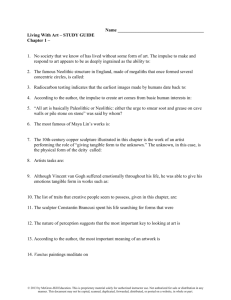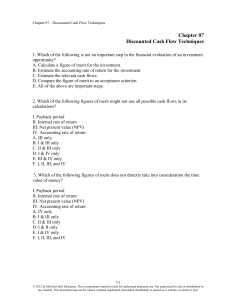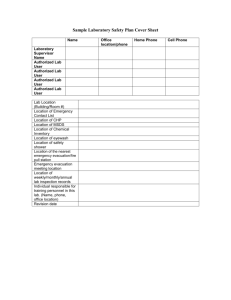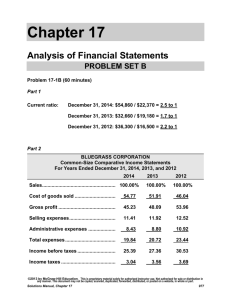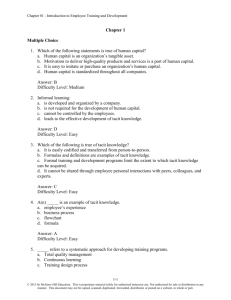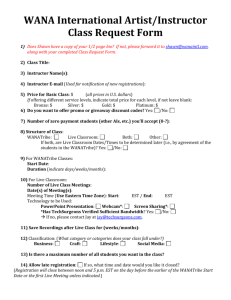CHAPTER 2
advertisement
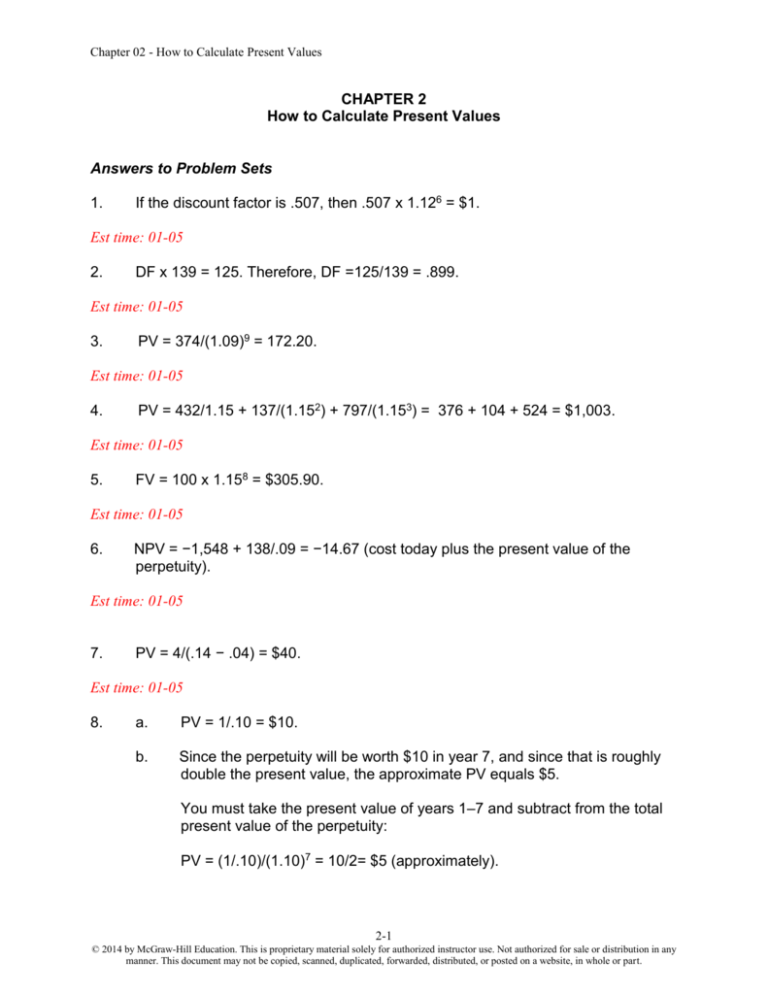
Chapter 02 - How to Calculate Present Values CHAPTER 2 How to Calculate Present Values Answers to Problem Sets 1. If the discount factor is .507, then .507 x 1.126 = $1. Est time: 01-05 2. DF x 139 = 125. Therefore, DF =125/139 = .899. Est time: 01-05 3. PV = 374/(1.09)9 = 172.20. Est time: 01-05 4. PV = 432/1.15 + 137/(1.152) + 797/(1.153) = 376 + 104 + 524 = $1,003. Est time: 01-05 5. FV = 100 x 1.158 = $305.90. Est time: 01-05 6. NPV = −1,548 + 138/.09 = −14.67 (cost today plus the present value of the perpetuity). Est time: 01-05 7. PV = 4/(.14 − .04) = $40. Est time: 01-05 8. a. PV = 1/.10 = $10. b. Since the perpetuity will be worth $10 in year 7, and since that is roughly double the present value, the approximate PV equals $5. You must take the present value of years 1–7 and subtract from the total present value of the perpetuity: PV = (1/.10)/(1.10)7 = 10/2= $5 (approximately). 2-1 © 2014 by McGraw-Hill Education. This is proprietary material solely for authorized instructor use. Not authorized for sale or distribution in any manner. This document may not be copied, scanned, duplicated, forwarded, distributed, or posted on a website, in whole or part. Chapter 02 - How to Calculate Present Values c. A perpetuity paying $1 starting now would be worth $10, whereas a perpetuity starting in year 8 would be worth roughly $5. The difference between these cash flows is therefore approximately $5. PV = $10 – $5= $5 (approximately). d. PV = C/(r − g) = 10,000/(.10-.05) = $200,000. Est time: 06-10 9. a. PV = 10,000/(1.055) = $7,835.26 (assuming the cost of the car does not appreciate over those five years). b. The six-year annuity factor [(1/0.08) – 1/(0.08 x (1+.08)6)] = 4.623. You need to set aside (12,000 × six-year annuity factor) = 12,000 × 4.623 = $55,475. c. At the end of six years you would have 1.086 × (60,476 - 55,475) = $7,935. Est time: 06-10 10. a. FV = 1,000e.12 x 5 = 1,000e.6 = $1,822.12. b. PV = 5e−.12 x 8 = 5e-.96 = $1.914 million. c. PV = C (1/r – 1/rert) = 2,000(1/.12 – 1/.12e .12 x15) = $13,912. Est time: 01-05 11. a. FV = 10,000,000 x (1.06)4 = 12,624,770. b. FV = 10,000,000 x (1 + .06/12)(4 x 12) = 12,704,892. c. FV = 10,000,000 x e(4 x .06) = 12,712,492. Est time: 01-05 12. a. PV = $100/1.0110 = $90.53. b. PV = $100/1.1310 = $29.46. c. PV = $100/1.2515 = $3.52. 2-2 © 2014 by McGraw-Hill Education. This is proprietary material solely for authorized instructor use. Not authorized for sale or distribution in any manner. This document may not be copied, scanned, duplicated, forwarded, distributed, or posted on a website, in whole or part. Chapter 02 - How to Calculate Present Values d. PV = $100/1.12 + $100/1.122 + $100/1.123 = $240.18. Est time: 01-05 13. a. DF1 1 0.905 r1 = 0.1050 = 10.50%. 1 r1 b. DF2 1 1 0.819. 2 (1 r2 ) (1.105) 2 c. AF2 = DF1 + DF2 = 0.905 + 0.819 = 1.724. d. PV of an annuity = C [annuity factor at r% for t years]. Here: $24.65 = $10 [AF3] AF3 = 2.465 e. AF3 = DF1 + DF2 + DF3 = AF2 + DF3 2.465 = 1.724 + DF3 DF3 = 0.741 Est time: 06-10 14. The present value of the 10-year stream of cash inflows is: 1 1 PV $170,000 $886,739.6 6 10 0.14 0.14 (1.14) Thus: NPV = –$800,000 + $886,739.66 = +$86,739.66 At the end of five years, the factory’s value will be the present value of the five remaining $170,000 cash flows: 1 1 PV $170,000 $583,623.7 6 5 0.14 0.14 (1.14) Est time: 01-05 2-3 © 2014 by McGraw-Hill Education. This is proprietary material solely for authorized instructor use. Not authorized for sale or distribution in any manner. This document may not be copied, scanned, duplicated, forwarded, distributed, or posted on a website, in whole or part. Chapter 02 - How to Calculate Present Values 15. 10 NPV t0 Ct $50,000 $57,000 $75,000 $80,000 $85,000 $380,000 t 1.12 (1.12) 1.12 2 1.12 3 1.12 4 1.12 5 $92,000 $92,000 $80,000 $68,000 $50,000 $23,696.15 1.12 6 1.12 7 1.12 8 1.12 9 1.12 10 Est time: 01-05 16. a. Let St = salary in year t. 30 PV t 1 40,000 (1.05) t 1 (1.08) t 1 (1.05) 30 40,000 $760,662.5 3 30 (.08 - .05) (.08 - .05) (1.08) b. PV(salary) x 0.05 = $38,033.13 Future value = $38,033.13 x (1.08)30 = $382,714.30 c. 1 1 PV C t r r (1 r) 1 1 $382,714.30 C 20 0.08 0.08 (1.08) 1 1 $38,980.30 C $382,714.30 0.08 0.08 (1.08) 20 Est time: 06-10 17. Period Present Value 0 400,000.00 2-4 © 2014 by McGraw-Hill Education. This is proprietary material solely for authorized instructor use. Not authorized for sale or distribution in any manner. This document may not be copied, scanned, duplicated, forwarded, distributed, or posted on a website, in whole or part. Chapter 02 - How to Calculate Present Values 1 2 3 +100,000/1.12 = +89,285.71 2 +200,000/1.12 = +159,438.78 +300,000/1.123 = +213,534.07 Total = NPV = $62,258.56 Est time: 01-05 18. We can break this down into several different cash flows, such that the sum of these separate cash flows is the total cash flow. Then, the sum of the present values of the separate cash flows is the present value of the entire project. (All dollar figures are in millions.) Cost of the ship is $8 million PV = $8 million Revenue is $5 million per year, and operating expenses are $4 million. Thus, operating cash flow is $1 million per year for 15 years. 1 1 PV $1 million $8.559 million. 15 0.08 0.08 (1.08) Major refits cost $2 million each and will occur at times t = 5 and t = 10. PV = ($2 million)/1.085 + ($2 million)/1.0810 = $2.288 million. Sale for scrap brings in revenue of $1.5 million at t = 15. PV = $1.5 million/1.0815 = $0.473 million. Adding these present values gives the present value of the entire project: NPV = $8 million + $8.559 million $2.288 million + $0.473 million NPV = $1.256 million Est time: 06-10 19. a. PV = $100,000. b. PV = $180,000/1.125 = $102,136.83. c. PV = $11,400/0.12 = $95,000. d. 1 1 PV $19,000 $107,354.2 4. 10 0.12 0.12 (1.12) e. PV = $6,500/(0.12 0.05) = $92,857.14. Prize (d) is the most valuable because it has the highest present value. Est time: 01-05 2-5 © 2014 by McGraw-Hill Education. This is proprietary material solely for authorized instructor use. Not authorized for sale or distribution in any manner. This document may not be copied, scanned, duplicated, forwarded, distributed, or posted on a website, in whole or part. Chapter 02 - How to Calculate Present Values 20. Mr. Basset is buying a security worth $20,000 now, which is its present value. The unknown is the annual payment. Using the present value of an annuity formula, we have: 1 1 PV C t r r (1 r) 1 1 $20,000 C 12 0.08 0.08 (1.08) C $20,000 1 1 $2,653.90 0.08 0.08 (1.08) 12 Est time: 01-05 21. Assume the Zhangs will put aside the same amount each year. One approach to solving this problem is to find the present value of the cost of the boat and then equate that to the present value of the money saved. From this equation, we can solve for the amount to be put aside each year. PV(boat) = $20,000/(1.10)5 = $12,418 1 1 PV(savings) = annual savings 5 0.10 0.10 (1.10) Because PV(savings) must equal PV(boat): 1 1 Annual savings $12,418 5 0.10 0.10 (1.10) 1 1 Annual savings $12,418 $3,276 5 0.10 0.10 (1.10) Another approach is to use the future value of an annuity formula: (1 .10) 5 1 $20,000 Annual savings .10 Annual savings = $ 3,276 Est time: 06-10 2-6 © 2014 by McGraw-Hill Education. This is proprietary material solely for authorized instructor use. Not authorized for sale or distribution in any manner. This document may not be copied, scanned, duplicated, forwarded, distributed, or posted on a website, in whole or part. Chapter 02 - How to Calculate Present Values 22. The fact that Kangaroo Autos is offering “free credit” tells us what the cash payments are; it does not change the fact that money has time value. A 10% annual rate of interest is equivalent to a monthly rate of 0.83%: rmonthly = rannual /12 = 0.10/12 = 0.0083 = 0.83% The present value of the payments to Kangaroo Autos is: 1 1 $1,000 $300 $8,938 30 0.0083 0.0083 (1.0083) A car from Turtle Motors costs $9,000 cash. Therefore, Kangaroo Autos offers the better deal, i.e., the lower present value of cost. Est time: 01-05 23. The NPVs are: at 5% NPV $700,000 $30,000 $870,000 $117,687 1.05 (1.05) 2 at 10% NPV $700,000 $30,000 870,000 $46,281 1.10 (1.10) 2 at 15% NPV $700,000 $30,000 870,000 $16,068 1.15 (1.15) 2 The figure below shows that the project has zero NPV at about 13.5%. As a check, NPV at 13.5% is: NPV $700,000 $30,000 870,000 $1.78 1.135 (1.135) 2 2-7 © 2014 by McGraw-Hill Education. This is proprietary material solely for authorized instructor use. Not authorized for sale or distribution in any manner. This document may not be copied, scanned, duplicated, forwarded, distributed, or posted on a website, in whole or part. Chapter 02 - How to Calculate Present Values Est time: 06-10 24. a. This is the usual perpetuity, and hence: PV b. C $100 $1,428.57 r 0.07 This is worth the PV of stream (a) plus the immediate payment of $100: PV = $100 + $1,428.57 = $1,528.57 c. The continuously compounded equivalent to a 7% annually compounded rate is approximately 6.77%, because: Ln(1.07) = 0.0677 or e0.0677 = 1.0700 Thus: PV C $100 $1,477.10 r 0.0677 2-8 © 2014 by McGraw-Hill Education. This is proprietary material solely for authorized instructor use. Not authorized for sale or distribution in any manner. This document may not be copied, scanned, duplicated, forwarded, distributed, or posted on a website, in whole or part. Chapter 02 - How to Calculate Present Values Note that the pattern of payments in part (b) is more valuable than the pattern of payments in part (c). It is preferable to receive cash flows at the start of every year than to spread the receipt of cash evenly over the year; with the former pattern of payment, you receive the cash more quickly. Est time: 06-10 25. a. PV = $1 billion/0.08 = $12.5 billion. b. PV = $1 billion/(0.08 – 0.04) = $25.0 billion. c. 1 1 PV $1 billion $9.818 billion. 20 0.08 0.08 (1.08) d. The continuously compounded equivalent to an 8% annually compounded rate is approximately 7.7%, because: Ln(1.08) = 0.0770 or e0.0770 = 1.0800 Thus: 1 1 PV $1 billion $10.203 billion (0.077)(20 ) 0.077 0.077 e This result is greater than the answer in Part (c) because the endowment is now earning interest during the entire year. Est time: 06-10 26. With annual compounding: FV = $100 (1.15)20 = $1,636.65. With continuous compounding: FV = $100 e(0.15×20) = $2,008.55. Est time: 01-05 27. One way to approach this problem is to solve for the present value of: (1) $100 per year for 10 years, and (2) $100 per year in perpetuity, with the first cash flow at year 11. If this is a fair deal, these present values must be equal, and thus we can solve for the interest rate (r). The present value of $100 per year for 10 years is: 2-9 © 2014 by McGraw-Hill Education. This is proprietary material solely for authorized instructor use. Not authorized for sale or distribution in any manner. This document may not be copied, scanned, duplicated, forwarded, distributed, or posted on a website, in whole or part. Chapter 02 - How to Calculate Present Values 1 1 PV $100 10 r (r) (1 r) The present value, as of year 10, of $100 per year forever, with the first payment in year 11, is: PV10 = $100/r. At t = 0, the present value of PV10 is: 1 $100 PV 10 (1 r) r Equating these two expressions for present value, we have: 1 1 $100 1 $100 10 10 r (r) (1 r) (1 r) r Using trial and error or algebraic solution, we find that r = 7.18%. Est time: 06-10 28. Assume the amount invested is one dollar. Let A represent the investment at 12%, compounded annually. Let B represent the investment at 11.7%, compounded semiannually. Let C represent the investment at 11.5%, compounded continuously. After one year: FVA = $1 (1 + 0.12)1 = $1.1200 FVB = $1 (1 + 0.0585)2 = $1.1204 FVC = $1 e(0.115 1) = $1.1219 After five years: FVA = $1 (1 + 0.12)5 = $1.7623 FVB = $1 (1 + 0.0585)10 = $1.7657 FVC = $1 e(0.115 5) = $1.7771 After twenty years: FVA = $1 (1 + 0.12)20 = $9.6463 FVB = $1 (1 + 0.0585)40 = $9.7193 FVC = $1 e(0.115 20) = $9.9742 The preferred investment is C. Est time: 06-10 2-10 © 2014 by McGraw-Hill Education. This is proprietary material solely for authorized instructor use. Not authorized for sale or distribution in any manner. This document may not be copied, scanned, duplicated, forwarded, distributed, or posted on a website, in whole or part. Chapter 02 - How to Calculate Present Values 29. Because the cash flows occur every six months, we first need to calculate the equivalent semiannual rate. Thus, 1.08 = (1 + r/2)2 => r = 7.846 semiannually compounded APR. Therefore the rate for six months is 7.846/2, or 3.923%: 1 1 PV $100,000 $100,000 $846,147 9 0 . 03923 0 . 03923 ( 1 . 03923 ) Est time: 06-10 30. a. Each installment is: $9,420,713/19 = $495,827. 1 1 PV $495,827 $4,761,724 19 0.08 0.08 (1.08) b. If ERC is willing to pay $4.2 million, then: 1 1 $4,200,000 $495,827 19 r r (1 r) Using Excel or a financial calculator, we find that r = 9.81%. Est time: 06-10 31. 1 1 PV $70,000 $402,264.7 3 8 0.08 0.08 (1.08) a. b. Year 1 2 3 4 5 6 7 8 Beginningof-Year Balance ($) 402,264.73 364,445.91 323,601.58 279,489.71 231,848.88 180,396.79 124,828.54 64,814.82 Year-End Interest on Balance ($) 32,181.18 29,155.67 25,888.13 22,359.18 18,547.91 14,431.74 9,986.28 5,185.19 Total Year-End Payment ($) 70,000.00 70,000.00 70,000.00 70,000.00 70,000.00 70,000.00 70,000.00 70,000.00 Amortization of Loan ($) End-of-Year Balance ($) 37,818.82 40,844.33 44,111.87 47,640.82 51,452.09 55,568.26 60,013.72 64,814.81 364,445.91 323,601.58 279,489.71 231,848.88 180,396.79 124,828.54 64,814.82 0.01 Est time: 06-10 32. This is an annuity problem with the present value of the annuity equal to $2 million (as of your retirement date), and the interest rate equal to 8% 2-11 © 2014 by McGraw-Hill Education. This is proprietary material solely for authorized instructor use. Not authorized for sale or distribution in any manner. This document may not be copied, scanned, duplicated, forwarded, distributed, or posted on a website, in whole or part. Chapter 02 - How to Calculate Present Values with 15 time periods. Thus, your annual level of expenditure (C) is determined as follows: 1 1 PV C t r r (1 r) 1 1 $2,000,000 C 15 0.08 0.08 (1.08) C $2,000,000 1 1 $233,659 0.08 0.08 (1.08)15 With an inflation rate of 4% per year, we will still accumulate $2 million as of our retirement date. However, because we want to spend a constant amount per year in real terms (R, constant for all t), the nominal amount (Ct) must increase each year. For each year t: R = Ct /(1 + inflation rate)t Therefore: PV [all Ct ] = PV [all R (1 + inflation rate)t] = $2,000,000 (1 0.04)1 (1 0.04) 2 (1 0.04)15 R . . . $2,000,000 1 2 (1 0.08)15 (1 0.08) (1 0.08) R [0.9630 + 0.9273 + . . . + 0.5677] = $2,000,000 R 11.2390 = $2,000,000 R = $177,952 (1 0 .08) 1 .03846. Then, redoing (1 0.04) the steps above using the real rate gives a real cash flow equal to: Alternatively, consider that the real rate is C $2,000,000 1 1 $177,952 0.03846 0.03846 (1.03846) 15 Thus C1 = ($177,952 1.04) = $185,070, C2 = $192,473, etc. Est time: 11-15 33. a. 1 1 PV $50,000 $430,925.8 9 12 0.055 0.055 (1.055) b. The annually compounded rate is 5.5%, so the semiannual rate is: 2-12 © 2014 by McGraw-Hill Education. This is proprietary material solely for authorized instructor use. Not authorized for sale or distribution in any manner. This document may not be copied, scanned, duplicated, forwarded, distributed, or posted on a website, in whole or part. Chapter 02 - How to Calculate Present Values (1.055)(1/2) – 1 = 0.0271 = 2.71% Since the payments now arrive six months earlier than previously: PV = $430,925.89 × 1.0271 = $442,603.98 Est time: 06-10 34. In three years, the balance in the mutual fund will be: FV = $1,000,000 × (1.035)3 = $1,108,718 The monthly shortfall will be: $15,000 – ($7,500 + $1,500) = $6,000. Annual withdrawals from the mutual fund will be: $6,000 × 12 = $72,000. Assume the first annual withdrawal occurs three years from today, when the balance in the mutual fund will be $1,108,718. Treating the withdrawals as an annuity due, we solve for t as follows: 1 1 PV C (1 r) t r r (1 r) 1 1 $1,108,718 $72,000 1.035 t 0.035 0.035 (1.035) Using Excel or a financial calculator, we find that t = 21.38 years. Est time: 06-10 35. a. PV = 2/.12 = $16.667 million. 1 1 b. PV = $2 $14.939 million. 20 0.12 0.12 (1.12) c. PV = 2/(.12-.03) = $22.222 million 1 1.03 20 d. PV = $2 $18.061 million. 20 (0.12 - .03) (0.12 - .03) (1.12) Est time: 06-10 36. a. First we must determine the 20-year annuity factor at a 6% interest rate. 20-year annuity factor = [1/.06 – 1/.06(1.06)20) = 11.4699. 2-13 © 2014 by McGraw-Hill Education. This is proprietary material solely for authorized instructor use. Not authorized for sale or distribution in any manner. This document may not be copied, scanned, duplicated, forwarded, distributed, or posted on a website, in whole or part. Chapter 02 - How to Calculate Present Values Once we have the annuity factor, we can determine the mortgage payment. Mortgage payment = $200,000/11.4699 = $17,436.91. b. Year 1 2 3 4 5 6 7 8 9 10 11 12 13 14 15 16 17 18 19 20 c. Beginning Balance ($) 200,000.00 194,563.09 188,799.96 182,691.05 176,215.60 169,351.63 162,075.81 154,363.45 146,188.34 137,522.73 128,337.19 118,600.51 108,279.62 97,339.49 85,742.95 73,450.61 60,420.74 46,609.07 31,968.71 16,449.92 Total YearEnd Payment ($) 17,436.91 17,436.91 17,436.91 17,436.91 17,436.91 17,436.91 17,436.91 17,436.91 17,436.91 17,436.91 17,436.91 17,436.91 17,436.91 17,436.91 17,436.91 17,436.91 17,436.91 17,436.91 17,436.91 17,436.91 Year-End Interest ($) 12,000.00 11,673.79 11,328.00 10,961.46 10,572.94 10,161.10 9,724.55 9,261.81 8,771.30 8,251.36 7,700.23 7,116.03 6,496.78 5,840.37 5,144.58 4,407.04 3,625.24 2,796.54 1,918.12 986.99 Amortization End-of-Year of Loan ($) Balance ($) 5,436.91 194,563.09 5,763.13 188,799.96 6,108.91 182,691.05 6,475.45 176,215.60 6,863.98 169,351.63 7,275.81 162,075.81 7,712.36 154,363.45 8,175.10 146,188.34 8,665.61 137,522.73 9,185.55 128,337.19 9,736.68 118,600.51 10,320.88 108,279.62 10,940.13 97,339.49 11,596.54 85,742.95 12,292.33 73,450.61 13,029.87 60,420.74 13,811.67 46,609.07 14,640.37 31,968.71 15,518.79 16,449.92 16,449.92 0.00 Nearly 69% of the initial loan payment goes toward interest ($12,000/$17,436.79 = .6882). Of the last payment, only 6% goes toward interest (987.24/17,436.79 = .06). After 10 years, $71,661.21 has been paid off ($200,000 – remaining balance of $128,338.79). This represents only 36% of the loan. The reason that less than half of the loan has paid off during half of its life is due to compound interest. Est time: 11-15 37. a. A 10-year annuity of $100 per year. 5% interest rate (to the nearest cent): 2-14 © 2014 by McGraw-Hill Education. This is proprietary material solely for authorized instructor use. Not authorized for sale or distribution in any manner. This document may not be copied, scanned, duplicated, forwarded, distributed, or posted on a website, in whole or part. Chapter 02 - How to Calculate Present Values = $772.17 15% interest rate (to the nearest cent): = b. $501.88 A 10-year annuity due of $100 per year (first cash flow arrives immediately). How does the switch from a standard annuity to an annuity due increase PV if the interest rate is 15% instead of 5%? 5% interest rate (to the nearest cent): = $810.78 = $577.16 15% interest rate (to the nearest cent): c. A 20-year annuity starting at $100 per year but growing at 5% per year. At the 5% rate, since the growth rate equals the discount rate, there will be a stream of 20 cash flows, each with a PV of $100. The total PV = $2000 At 15% (to the nearest cent): = d. $837.88 A 20-year annuity starting at $100 per year but declining at 5% per year. At 5% (to the nearest cent): = $864.89 = $489.05 At 15% (to the nearest cent): 2-15 © 2014 by McGraw-Hill Education. This is proprietary material solely for authorized instructor use. Not authorized for sale or distribution in any manner. This document may not be copied, scanned, duplicated, forwarded, distributed, or posted on a website, in whole or part. Chapter 02 - How to Calculate Present Values 38. a. Using the Rule of 72, the time for money to double at 12% is 72/12, or six years. More precisely, if x is the number of years for money to double, then: (1.12)x = 2 Using logarithms, we find: x (ln 1.12) = ln 2 x = 6.12 years b. With continuous compounding for interest rate r and time period x: e rx = 2 Taking the natural logarithm of each side: rx = ln(2) = 0.693 Thus, if r is expressed as a percent, then x (the time for money to double) is: x = 69.3/(interest rate, in percent). Est time: 06-10 39. Spreadsheet exercise. Est time: 11-15 40. a. This calls for the growing perpetuity formula with a negative growth rate (g = –0.04): PV b. $2 million $2 million $14.29 million 0.10 ( 0.04) 0.14 The pipeline’s value at year 20 (i.e., at t = 20), assuming its cash flows last forever, is: PV20 C21 C (1 g)20 1 rg rg With C1 = $2 million, g = –0.04, and r = 0.10: PV20 ($2 million) (1 0.04)20 $0.884 million $6.314 million 0.14 0.14 Next, we convert this amount to PV today, and subtract it from the answer to Part (a): $6.314 million PV $14.29 million $13.35 million (1.10) 20 2-16 © 2014 by McGraw-Hill Education. This is proprietary material solely for authorized instructor use. Not authorized for sale or distribution in any manner. This document may not be copied, scanned, duplicated, forwarded, distributed, or posted on a website, in whole or part. Chapter 02 - How to Calculate Present Values Est time: 06-10 2-17 © 2014 by McGraw-Hill Education. This is proprietary material solely for authorized instructor use. Not authorized for sale or distribution in any manner. This document may not be copied, scanned, duplicated, forwarded, distributed, or posted on a website, in whole or part.

